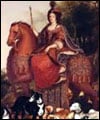
Polish traditions at your next family wedding.

From time to time I receive inquiries from all over
At a Polish wedding, the bride’s father does not give his daughter away at church — she’s not a piece of property!
What is important is the parental blessing which takes place at the home of the bride prior to the church ceremony. The bridegroom goes to the bride’s home to take her to church, but first her parents bestow their blessing on the bride and groom – to – be. A crucifix, a lighted candle, a bowl of holy water and a sprinkler (if the regular Polish brush-type sprinkler is not available, this can be a leafy tree branch) should be prepared. Flowers in a vase are always a nice touch. Either kneelers or fancy cushions are provided for the bride and groom to kneel on. They hold hands as they kneel in front of their parents. Traditionally the mother of the bride gives the blessing. Here is one of many possible blessings:
„Niech Pan Bóg wszechmog1cy obdarzy Was zdrowiem, szczesciem i wzajemna miloscia na Waszej nowej, wspólnej drodze zycia i niech Was poblogoslawi licznym, zdrowym potomstwem — owocem Waszej miloci. I ja Was blogoslawie: W imie Ojca i Syna i Ducha Swietego. Amen.”
(Translation: May God Almighty grant you health, happiness and mutual love on your new road through life together and may He bless you with numerous, healthy children — the fruit of your love. And I also bless you: In the name of the Father, and of the Son and of the Holy Ghost. Amen.)
The mother then sprinkles the bride and groom – to – be with Holy Water, whereupon they make the Sign of the Cross. She then gives them the crucifix to kiss. The father of the bride may utter a blessing of his own or simply sprinkle the couple with Holy Water. The bridegroom’s parents may also impart their blessing. Others, for instance grandparents, or godparents may also bless the couple.
After the blessing, the bride and groom thank, hug and kiss their parents and the wedding party prepares to leave for church. (The wedding party usually comprises the parents, bridesmaids and groomsmen, the young couple’s siblings, possibly also grandparents, godparents or other close relatives or friends of the family.
As the bridal party leaves, musicians (perhaps only a single accordionist) plays 'Serdeczna Matko’.
The betrothed enter the church together as fiancés and leave it as man and wife. Hymns played and/or sung during the ceremony traditionally include 'Veni Creator’ and Gounod’s 'Ave Maria’. Mendelssohn’s 'Wedding March’ is usually played as the recessional hymn when the bride and groom walk down the aisle to the back of the church after the ceremony as man and wife.
A highly symbolic Polish touch during the marriage ceremony is the priest’s blessing. The bride and groom’s entwined hands are wrapped with the priest’s stole as a sign of permanent unity in the eyes of God and the
















